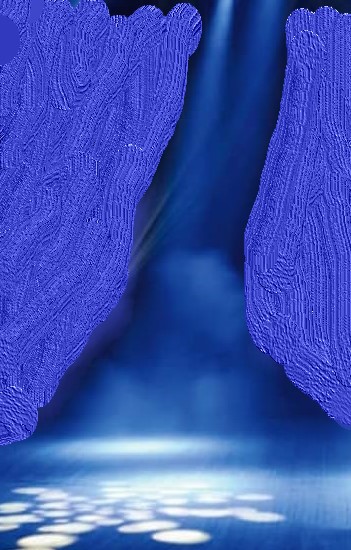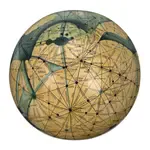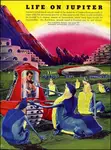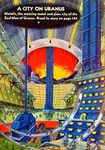a brief history of ooranye
20: the praesodymium spotlight
[continued from 19: The Foam]

The Foam was no more. Its powdery relic, strewn in dusty whiffs on city floor and plain, gradually evaporated or – when in contact with existing granules – reverted to gralm.
The legacy of the Foam, however, is still with us.
The Era of the Foam created perhaps the greatest divide in Uranian history since the robbery of Chelth or the defeat of Fiarr Fosn. But the full reason for this only gradually became apparent during the following era (the Fifty-Ninth).
This was the colossal Praesodymium Era: 23,493,050 U-days; 957 U-years, = 80,400 Earth years.
During this immense span of time, Syoom was, objectively speaking, a pale shadow of what it had been.
Physical reasons for the change are obvious enough. Syoom had been debilitated as never before or since. The Foam had left the land vastly less fertile. This meant diminished yields from the vheic plants; it would be a long time before the familiar fields of glowing blue or golden vheic could once more symbolise Syoom. Praesodymium Era fields, smaller in extent than those of yore, glowed a dim orange. They were beautiful to look at but their type of beauty was a sign of great reduction in material wealth.
Yet in some ways the Praesodymium was an era of unparalleled splendour. To understand this apparent contradiction, we must face up to the knottiest task of a historian, as we attempt to distinguish between two types of people, or two types of life-story.
The distinction we are going to make is one which is bound to seem fantastically odd to Earth readers because (we presume) it does not exist on Earth, at any rate not outside of fiction, and even in fiction it has never been explicitly stated. Nor, perhaps, did it exist on Ooranye either, before Era 59; or at any rate nowhere near as evidently as the mark it made after the Foam had come and gone. So what, precisely, is this new divide?
Earthlings have contrasts between rich and poor, talented and untalented, good and bad, handsome and ugly, lucky and unlucky, famous and obscure. Uranians from Era 59 onwards added another pair of opposites to this list. They become sortable into their own two distinctive categories, the spot-lit and the non spot-lit.
It is as though life is a film-script, favouring some of the cast with the status of star, while leaving others with that of “extra”.
Ideally we would not be obliged to say much about this strange phenomenon, other than to point out that any student of Uranian affairs becomes aware of it after a certain while. The Uranians themselves hardly ever mention it. It is felt rather than talked about. Easier to leave it at that. And wiser, too; for it is considered very bad form to raise the issue.
The trouble is, the immense philosophical and scientific questions which it raises need to be addressed if we are to have any chance of understanding the second half of this History. What, precisely, is going on? Are there really currents of fate? If so, can some people deliberately edge themselves into them, like skilled or foolhardy canoeists, while others are left high and dry? Or are the answers to be found somewhere in the uncharted domain of “luck”?
If any Uranian knows, nen is not telling.
Whatever the answer, from Era 59 onwards the Uranians whom we know much about are, by definition, “spot-lit”. The others, the supporting cast, generally lead happy enough lives, contented to play their role as “extras” in history; or maybe they see it differently, for after all the soul’s journey is what matters, “spotlight” or no.
During the long stretch of the Praesodymium Era, hundreds of millions of Uranians led lives reduced by poverty, to a degree unprecedented in history, yet, because of their “background” status - their solid identity as supporting cast - they did not suffer the rootless discontent which might otherwise have tormented them into attempts to find other ways of living.
It is only fair to add that the account given above, the “realist” account, is disputed by many ooranologists. These “nominalists” maintain that it all merely amounts to a different manner of talking about life; a manner which needed to emerge in Era 59 as a way to explain why so many folk were content to remain humble. To assume that there is anything real in “spot-lit” versus “non spot-lit” is pure superstition, say these experts.
They go on to argue that, after all, in all ages there have been the ambitious, the charismatic, the famous few contrasted with the ordinary, obscure, contented many; all that happened in the Praesodymium Era was that the exploits of those famous few gave a greater degree of vicarious comfort than before, in the straightened conditions of that time. It is not surprising that fortune in such circumstances favours the bold and the lucky even more than it does in other eras.
To this view we may reply with a “hmmmm…” It may be significant to note the way in which some regimes in this era went bad: some wicked rulers were sustained by their exploitation of leaderless “backgrounders”. The same is true of the tyrant Dempelath as recounted in Uranian Throne. Whether this favours the “realist” or the “nominalist” theory is a moot point.
We also cannot resist pointing out that the era ended with an adventure undertaken by the person who, if there is anything in the term “spot-lit”, must be ranked as one of the most spot-lit Nenns of all time: the only person ever to be Sunnoad twice, in two different incarnations: Restiprak Zentonan 33337 / 45329.





































